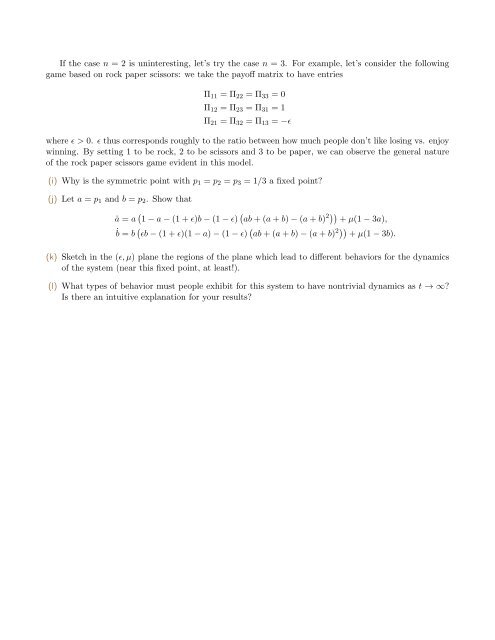Rock Paper Scissors - People.fas.harvard.edu
Rock Paper Scissors - People.fas.harvard.edu
Rock Paper Scissors - People.fas.harvard.edu
You also want an ePaper? Increase the reach of your titles
YUMPU automatically turns print PDFs into web optimized ePapers that Google loves.
If the case n = 2 is uninteresting, let’s try the case n = 3. For example, let’s consider the following<br />
game based on rock paper scissors: we take the payoff matrix to have entries<br />
Π 11 = Π 22 = Π 33 = 0<br />
Π 12 = Π 23 = Π 31 = 1<br />
Π 21 = Π 32 = Π 13 = −ɛ<br />
where ɛ > 0. ɛ thus corresponds roughly to the ratio between how much people don’t like losing vs. enjoy<br />
winning. By setting 1 to be rock, 2 to be scissors and 3 to be paper, we can observe the general nature<br />
of the rock paper scissors game evident in this model.<br />
(i) Why is the symmetric point with p 1 = p 2 = p 3 = 1/3 a fixed point?<br />
(j) Let a = p 1 and b = p 2 . Show that<br />
ȧ = a ( 1 − a − (1 + ɛ)b − (1 − ɛ) ( ab + (a + b) − (a + b) 2)) + µ(1 − 3a),<br />
ḃ = b ( ɛb − (1 + ɛ)(1 − a) − (1 − ɛ) ( ab + (a + b) − (a + b) 2)) + µ(1 − 3b).<br />
(k) Sketch in the (ɛ, µ) plane the regions of the plane which lead to different behaviors for the dynamics<br />
of the system (near this fixed point, at least!).<br />
(l) What types of behavior must people exhibit for this system to have nontrivial dynamics as t → ∞?<br />
Is there an intuitive explanation for your results?
















